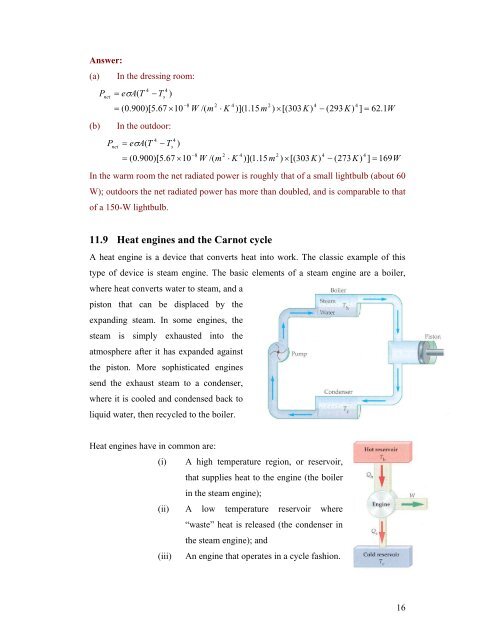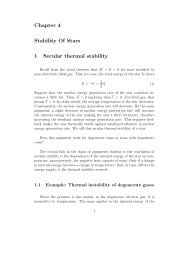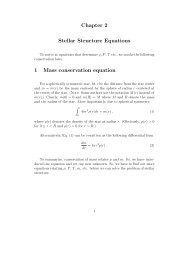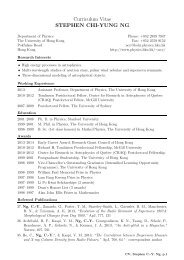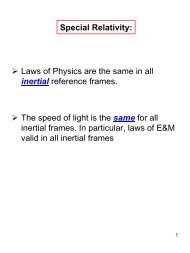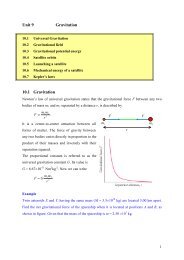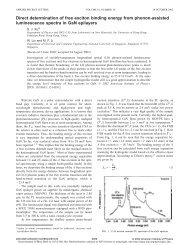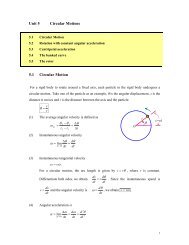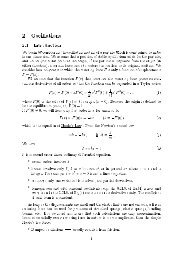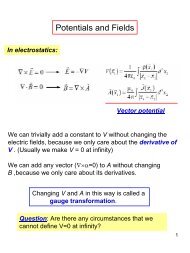Thermal Behavior of Matter and Heat Engines - Department of ...
Thermal Behavior of Matter and Heat Engines - Department of ...
Thermal Behavior of Matter and Heat Engines - Department of ...
Create successful ePaper yourself
Turn your PDF publications into a flip-book with our unique Google optimized e-Paper software.
Answer:<br />
(a) In the dressing room:<br />
P<br />
net<br />
= eσA(<br />
T<br />
4<br />
− T<br />
4<br />
s<br />
= (0.900)[5.67 × 10<br />
)<br />
−8<br />
W /( m<br />
2<br />
⋅ K<br />
4<br />
2<br />
)](1.15m<br />
) × [(303 K)<br />
4<br />
− (293 K)<br />
4<br />
] = 62.1W<br />
(b)<br />
P<br />
net<br />
In the outdoor:<br />
= eσA(<br />
T<br />
4<br />
− T<br />
4<br />
s<br />
= (0.900)[5.67 × 10<br />
)<br />
−8<br />
W /( m<br />
2<br />
⋅ K<br />
4<br />
2<br />
)](1.15m<br />
) × [(303 K)<br />
4<br />
− (273 K)<br />
4<br />
] = 169W<br />
In the warm room the net radiated power is roughly that <strong>of</strong> a small lightbulb (about 60<br />
W); outdoors the net radiated power has more than doubled, <strong>and</strong> is comparable to that<br />
<strong>of</strong> a 150-W lightbulb.<br />
11.9 <strong>Heat</strong> engines <strong>and</strong> the Carnot cycle<br />
A heat engine is a device that converts heat into work. The classic example <strong>of</strong> this<br />
type <strong>of</strong> device is steam engine. The basic elements <strong>of</strong> a steam engine are a boiler,<br />
where heat converts water to steam, <strong>and</strong> a<br />
piston that can be displaced by the<br />
exp<strong>and</strong>ing steam. In some engines, the<br />
steam is simply exhausted into the<br />
atmosphere after it has exp<strong>and</strong>ed against<br />
the piston. More sophisticated engines<br />
send the exhaust steam to a condenser,<br />
where it is cooled <strong>and</strong> condensed back to<br />
liquid water, then recycled to the boiler.<br />
<strong>Heat</strong> engines have in common are:<br />
(i) A high temperature region, or reservoir,<br />
that supplies heat to the engine (the boiler<br />
in the steam engine);<br />
(ii) A low temperature reservoir where<br />
“waste” heat is released (the condenser in<br />
the steam engine); <strong>and</strong><br />
(iii) An engine that operates in a cycle fashion.<br />
16


